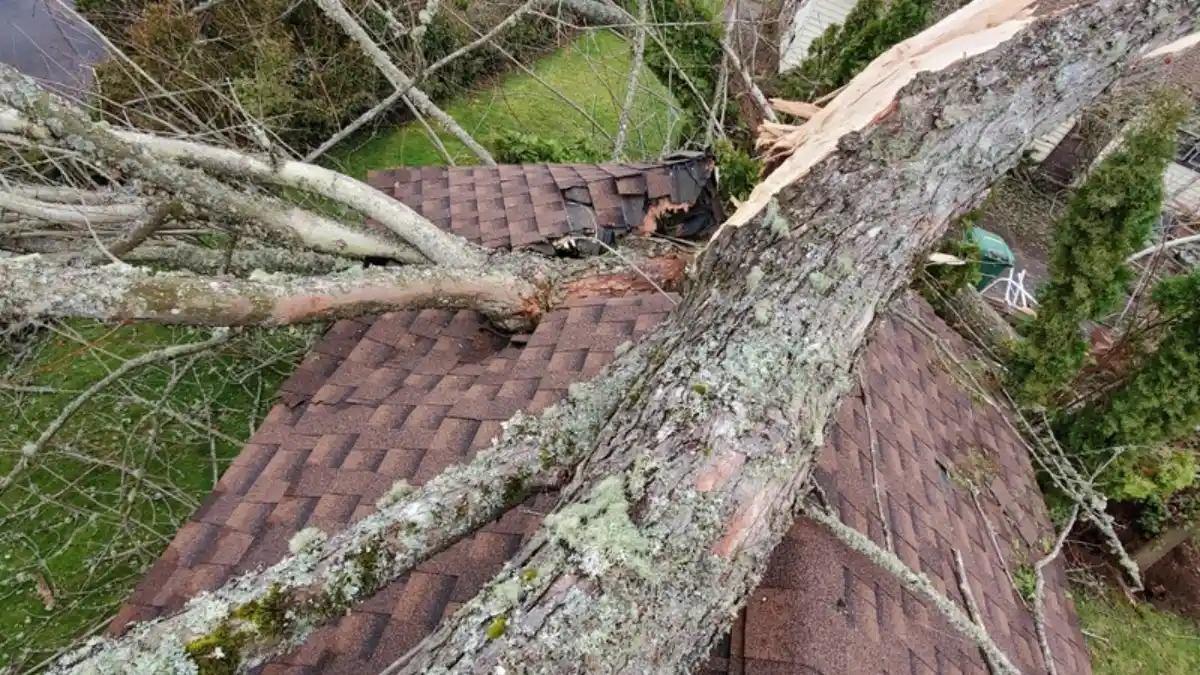A hail-damaged roof can have significant implications for homeowners, including the need for timely repairs and potential insurance claims. We at River City Roofing, having 20+ years of experience, understand the importance of knowing how to tell if your roof has hail damage. After a severe hail storm, homeowners often wonder about the condition of their roofs. Identifying hail damage early can prevent costly repairs and ensure the longevity of your home’s protective covering.
In this guide, we’ll walk you through the process of spotting hail damage on your roof. We’ll cover how to conduct a visual inspection, what roof hail damage looks like on different materials, and when to call a professional for a thorough roof inspection. By the end, you’ll be better equipped to check your roof for hail damage and make informed decisions about repairs or insurance claims.
Understanding the Nature of Hail Damage
Hail roof damage can vary significantly based on several factors. To grasp the full impact of hail on roofing materials, it’s essential to understand the different types of damage, their immediate and long-term effects, and the factors that influence the severity of the damage.
Types of Hail Damage
Hail can cause both functional and cosmetic damage to roofs. Functional damage affects the roof’s integrity and longevity, while cosmetic damage doesn’t impact its performance. Common types of hail damage include:
- Granule loss on asphalt shingles
- Cracks or punctures in shingles
- Exposed or fractured fiberglass mat
- Weakened self-seal strips
- Dents or dimples in metal or foam roofs
- Cracked or shattered clay or concrete tiles
Immediate vs. Long-Term Effects
Immediate effects of hail damage may seem minor, but they can lead to significant long-term consequences if left unaddressed:
- Water leaks and intrusion
- Mold and mildew growth
- Reduced roof lifespan
- Decreased energy efficiency
- Structural weakening
- Increased repair costs over time
- Potential insurance claim complications
Factors Affecting Damage Severity
The severity of hail damage from hail storms depends on various factors:
- Hail size and density
- Wind speed and direction
- Roofing material type and age
- Roof slope and construction quality
- Presence of barriers (trees, adjacent buildings)
Table: Hail Size and Potential Damage
| Hail Size | Potential Damage |
| 1 inch | Organic 3-tab shingles |
| 1¼ inch | Fiberglass shingles, cedar shingles, flat concrete tiles |
| 1½ inch | Heavy wood shakes, thicker fiberglass shingles |
| 2 inches | Concrete S-tiles |
Understanding these aspects of hail damage helps homeowners recognize the importance of prompt inspection and repair after a hailstorm to prevent long-term issues and maintain their roof’s integrity.
Conducting a Visual Roof Inspection
Ground-Level Assessment
A homeowner can begin their inspection from the ground. They should choose a sunny day for better visibility and take a look at their roof from a distance. This initial assessment helps identify obvious signs of damage, such as missing shingles or visible dents. It’s also important to check for collateral damage, including dents on gutters, gutter screens, and downspouts. Examining siding, windowsills, air conditioners, and decks can provide additional clues about potential roof damage.
Safely Inspecting the Roof
Safety should be the top priority when conducting a roof inspection. Homeowners should use a sturdy ladder and wear appropriate safety gear, including non-slip shoes and a helmet. It’s crucial to never inspect a roof alone; always have someone present for assistance. When on the roof, look for circular pits or divots in shingles, loss of granules, splits or cracks, and missing or torn shingles. Check soft metal components like roof vents for noticeable dings and dents.
Using Binoculars for a Closer Look
For those uncomfortable with climbing onto the roof, binoculars offer a safer alternative. They allow for a detailed examination of different roof areas without the associated risks. When using binoculars, focus on identifying damage to skylights, trim, and other roofing features. Look for dark spots on shingles, which may indicate granule loss. Also, inspect gutters and exposed flashing for signs of impact.
Inside the home, keep an eye out for water stains on ceilings and walls, as these might indicate hail damage allowing water penetration. Remember, while a visual inspection can provide valuable information, it’s often best to leave thorough assessments to experienced roofing professionals who can safely and accurately evaluate the extent of hail damage.
Identifying Hail Damage on Different Roofing Materials
Asphalt Shingle Hail Damage Signs
Hail damage to asphalt shingles can be subtle or obvious. Signs include:
- Random damage patterns
- Black-colored hail hits
- Loss of granules, exposing roof felt
- Shiny asphalt or mat
- Soft spots, similar to bruises on an apple
Granule displacement is common, exposing underlying asphalt to harmful UV rays. This exposure can lead to cracking, blistering, and water leaks.
Metal Roofing Hail Damage Indicators
Metal roofs are generally resistant to hail damage, but can still be affected:
- Denting: Mainly cosmetic, doesn’t cause roof failure
- Puncturing: More severe, can lead to leaks
Factors influencing metal roof damage:
- Hail size
- Metal gage (thinner is more susceptible)
- Roof slope (steeper slopes deflect hail better)
- Panel design (structured panels conceal damage better)
- Roof deck presence
- Metal embossing
- Finish type (matte finishes hide damage better)
Tile and Slate Roof Hail Damage
Tile and slate roofs can suffer significant damage from hail:
- Puncture holes
- Cracks
- Broken pieces
For slate roofs:
- Look for indentations, especially at corners and seams
- Check for hairline cracks, fractures, or chips
- Inspect other roof components (valleys, flashing, gutters)
Quality S-1 rated slate is highly resistant to hail. However, poor quality slate or improper installation can increase vulnerability. If 20-30% of slates are damaged, full roof replacement may be necessary.
When and How to Seek Professional Help
Signs That Warrant Expert Inspection
After a hailstorm, homeowners should look for these signs that indicate the need for professional inspection:
- Shingles on the ground
- Asphalt granules in gutters
- Fallen gutters or visible damage to metal components
- Dents or dings on metal surfaces (vents, flashing)
- Water stains on ceilings or walls
If any of these signs are present, it’s crucial to call a professional roofing contractor for a thorough assessment. To understand what does hail damage look like on a roof, look for bruising on shingles, cracked or missing shingles, and damage to roof vents and skylights.
Choosing a Qualified Roofing Contractor
When selecting a roofing contractor, homeowners should:
- Choose a local company with at least 5 years of business experience
- Verify the company has an established place of business for 2+ years
- Check Better Business Bureau ratings and online reviews
- Ensure the contractor has proper insurance and licenses
- Avoid door-to-door salespeople and out-of-state contractors
What to Expect from a Professional Assessment
A professional roof inspection typically includes:
- Examination of shingles, gutters, flashing, and other roof components
- Inspection of soffit, fascia, siding, and windows
- Assessment of subroofing material and decking
- Evaluation of chimney and outdoor appliances
- Check for hidden damage like water leaks in the attic
After the inspection, the contractor will provide a detailed estimate for repairs or replacement. Homeowners should ask questions about identified damage and recommended repairs. It’s advisable to have the roofing contractor meet with the insurance adjuster to discuss and explain any damage found during the inspection.
Conclusion
Understanding the signs of hail damage on your roof is crucial for maintaining your home’s integrity and preventing costly repairs down the line. By conducting regular visual inspections, recognizing damage patterns on different roofing materials, and knowing when to call in the experts, homeowners can better protect their investment. This knowledge empowers you to make informed decisions about repairs and insurance claims.
Remember, while DIY inspections are helpful, they’re no substitute for professional assessments. If you suspect hail damage, don’t hesitate to reach out to professional roofing contractors for a thorough evaluation. Taking prompt action can save you money and headaches in the long run, ensuring your roof continues to shield your home effectively for years to come.
FAQs
Signs of hail damage on a roof can include discoloration resembling polka dots, granules from shingles accumulating in gutters or downspouts, water spots on your ceiling, or visible cracks and dents on shingles.
On rubber or fiberglass roofs, hail damage may manifest as cracks or fractures. These damages can be subtle but are critical indicators of severe hail impact, requiring immediate attention to prevent water from seeping in and causing further damage.
A damaged roof generally displays missing or cracked shingles, water leakage in the attic, or compromised flashing. Recognizing these signs is crucial for timely roof maintenance or replacement.
Hail must be at least 1 inch in diameter to significantly damage a roof and justify filing an insurance claim. Hail this size or larger can lead to substantial damage, necessitating roof repair or replacement.



Comments are closed